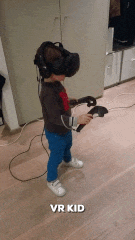VR NEED FOR «WOW-EFFECT»

Why exactly do you need a wow effect»? How will you measure how the «wow effect» affected sales?
Often marketers just take what they can't measure and label it with «wow effect», because it can be «sold» to the CEO.
VR is a tool for visual communication with the client. Do you use LCD video for a «wow-effect»? Five years ago, you probably would. Not today. You use it to answer questions and form expectations. VR is used for the same purpose.
NUMBERS
According to the American study of Coldwell Banker Real Estate, conducted in 2016-2017, 62% of buyers will prefer the seller of real estate offering VR-tours.
According to a study by VRARA in Russia, УUkraine and Belarus, conducted in 2017, 40,4% of all buyers of apartments confirmed that for them personally, panoramic tours are valuable for making a decision about the purchase. Among those whose developer offers panoramic tours, share a positive view panoramic tours reached 72,7%.
VR DOES NOT AFFECT SALES

This was invented by marketers who do not know how to conduct measurable pilot projects. In the scheme "ordered one layout-posted on the website-waiting for sales", obviously, there is some flaw.
VR is not a conversion tool, it is a tool of visual communication with the client. Can you quantify how the presence of the booklet affects sales? Can you measure how your video affects sales? If Yes, you can measure and influence VR.
VR — brand appliances, applications, popular tool. Like a hammer. But its effectiveness depends on how and who will hammer the nails.
NUMBERS
According to Coldwell Banker Real Estate, 77% of buyers would like to be able to view VR tours before visiting the property.
According to the results of A/B testing of the site of the LCD "Vienna block" in 2018, the availability of 3D floor plans and panoramic tours will increase the conversion rate in a call for 10% in comparison with the card flat, containing only the 2D layout. Behavioral factors are also improving: viewing depth has increased by 22%, and time on the site — by 13%.
According to a study by VRARA in Russia, Ukraine and Belarus, 55,8% of all apartment buyers confirm that visual, 3D and VR content definitely help them to compare offers from different developers. Among those who saw panoramic tours when looking for housing, the share reached 65,5%.
45,2% of all apartment buyers confirm that 3D and VR content content definitely help them to make a decision to buy faster, than just 2D layout.
70,2% of all buyers of apartments confirm that 3D-and VR-content definitely help them to discuss offers with family, relatives, friends.Among those who saw panoramic tours when looking for housing, the share reached 79,3%.
HELMETS MAKE YOU FEEL SICK, THERE IS NO EFFECT OF IMMERSION, IT IS UNREALISTIC

Maybe if you last tested the build on a Samsung Gear VR in 2016. VR is a young industry, so it is very fast changing both hardware and software technologies and the experience of companies.
Major hardware manufacturers (Google, HTC, Facebook and others) are struggling to reduce delays. Increases the performance of processors and graphics cards. At the same time, developers of VR solutions learn how to make them more secure for users.
So be sure to compare each new experience offered to you. Even if you see a company at the show with a helmet walk on Windows MR, and you've tried this set of technologies before, you know: this time it can be very different.
NUMBERS
According to the study of VRARA in Russia, Ukraine and Belarus, 72,1%of all buyers of apartments confirm that the ability to compare offers without having to go to the object is a positive factor in the choice of the developer.
64,4% of all buyers of apartments confirm that 3D-and VR-content definitely help them understand the size and volume of rooms purchased housing.
65,4% of all apartment buyers confirm that 3D and VR content definitely help me understand the views from the Windows and the spatial orientation of the purchased property. Among those who saw panoramic tours when looking for housing, the share reached 75,9%.
YOU NEED MAXIMUM INTERACTIVITY AND GAMIFICATION!

Give me a working kettle in the kitchen and a bowling alley in the nursery! Let the buyer of the apartment collects gold tokens for a discount in virtual Mops!
OK, but what specific communicative task will it solve?
VR is a visual communication tool that is needed to remove fears, answer questions and form the necessary expectations from the buyer regarding the future of the residential complex and apartment. This tool fits into the overall sales sequence. Whether you need to buyer a half hour playing skittles, but did not know about the benefits plan?
Interactivity must be justified by a business task. Spread out the sofa in the Studio to show that the refrigerator door opens? Quite. To change three options of finishing which are offered by the Builder? Certainly. To give the buyer the opportunity to move and change the furniture? Most likely, this will not contribute to the valuable communication for the developer.
NUMBERS
According to the study of VRARA in Russia, Ukraine and Belarus, the majority of apartment buyers ( 62,5% of all respondents) think about the decoration and furnishing of housing only after signing the contract with the developer. 15,4% of all buyers of apartments, on the contrary, think about the finishing and furnishing of housing before the first contact with the developers.
Home buyers are divided into three large groups. Visuals ( 47,1% of respondents) have no problems to imagine the future of the room. «Logics» ( 31,7% of respondents) believe that it is difficult for them to visualize, present the decoration and furnishings. Uncertain ( 21,2% of the respondents) are hesitant in assessing their spatial imagination.
«Visuals» refer to 3D content in much the same way as the audience on average.
«Uncertain» appreciated is 3D-content more, as well as the accuracy and realism of the images. At the same time, 2D layouts are less valuable for them. "Uncertain" appreciated developers who provide them with 3D-content much more. 59,1% claim that 3D content definitely helps them make the decision to purchase faster, than just 2D layouts.
«Logics» price is the main factor, they appreciate 2D and 3D content (including videos and panoramic tours) much less. At the same time, they value VR tours more than the rest of the audience ( 33,3% percent rate them as valuable for making purchasing decisions).
ONLY THE YOUNG GENERATION NEEDS VR

This is a manifestation of the so-called «magical thinking». Young people – young technology. Pen-pineapple-apple-pen.
Both surveys and simple observations of customers in sales offices and at exhibitions show that the situation is exactly the opposite.
NUMBERS
According to the VRARA study in Russia, Ukraine and Belarus, respondents of different ages are equally concerned about the importance of content, with two exceptions. The age group (40-60 years) compared to young people (20-29 years) is noticeably more positive about panoramic tours (48.1% vs. 31.4%) and videos (33.3% vs. 17.1%).
A more adult audience (30-39 years old) compared to young people (20-29 years old) estimates 3D and VR content as a tool for comparing developers ( 61,9% against 48,6%), a tool for comparing offers without going to the object ( 81,0% against 57,1%), and as a tool for faster decision - making on purchase ( 52,4% against 37,1%).
VR FOR REAL ESTATE IS EXPENSIVE

In 2008, the visualization of the exterior of the LCD was the lot of only business and luxury housing. For 10 years the situation has changed dramatically, despite the fact that the cost of modeling for that time has not decreased. That is, developers have learned to lay the cost of production of content in the construction budget. What prevents you from doing the same with VR tools?
If we consider the modeling of the interior of the entire LCD in the format of mobile VR (where we recommend to start), one typical layout will cost 15-18 thousand rubles. In terms of one physical apartment — less than 2000 rubles for one sale. Assembly for a full-scale VR will cost 40-50 thousand rubles for a standard layout, that is less than 5000 rubles for one physical apartment.
A walk in full-scale VR environment LCD and Mops on average in the market is in the range of 300-1000 thousand rubles, that is, within 3-10 thousand rubles per physical apartment, and in the case of mass housing — even lower. In mobile VR you can gather panoramic tour half the price of the bottom bracket VR tour.
In business communication there is no such a word as "expensive". It is more likely "didn't bother to allocate a budget for it".
